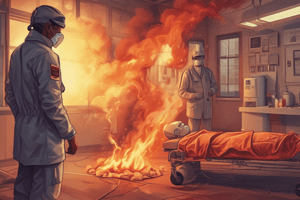Podcast
Questions and Answers
What is the primary aim of the 'E' component in the initial assessment of a burn patient?
What is the primary aim of the 'E' component in the initial assessment of a burn patient?
- To perform a secondary survey
- To initiate fluid resuscitation
- To expose the patient to assess the burn area and check for concomitant injuries (correct)
- To provide analgesia to the patient
What should be considered when estimating the burn area?
What should be considered when estimating the burn area?
- The Lund and Browder chart is only used for pediatric patients
- The patient's age should be considered
- Erythema should be included in the estimation
- Erythema should not be included in the estimation (correct)
What is the purpose of using the palmar surface method in assessing burn area?
What is the purpose of using the palmar surface method in assessing burn area?
- To estimate small burns in adults (correct)
- To estimate the total body surface area
- To estimate large burns in adults
- To estimate small burns in children
What is the recommended airway management for patients with >60% FT with inhalation?
What is the recommended airway management for patients with >60% FT with inhalation?
Why is the Lund and Browder chart preferred in children?
Why is the Lund and Browder chart preferred in children?
Which of the following is not a criterion for transferring children to a burn center?
Which of the following is not a criterion for transferring children to a burn center?
Why is it important to touch the wounds during the assessment of burn area?
Why is it important to touch the wounds during the assessment of burn area?
What is the primary goal of fluid resuscitation in burn patients?
What is the primary goal of fluid resuscitation in burn patients?
What is the recommended analgesic for patients with large burns?
What is the recommended analgesic for patients with large burns?
What type of dressings are used for transfer wound coverage?
What type of dressings are used for transfer wound coverage?
What is the recommended percentage of BSA for skin grafting per sitting?
What is the recommended percentage of BSA for skin grafting per sitting?
Why is a urinary catheter mandatory in burns >20% TBSA?
Why is a urinary catheter mandatory in burns >20% TBSA?
Which of the following is not a part of the rehabilitation team?
Which of the following is not a part of the rehabilitation team?
What is the purpose of the secondary survey?
What is the purpose of the secondary survey?
What type of energy is responsible for burns?
What type of energy is responsible for burns?
What is the primary focus of the primary survey in a major burn patient?
What is the primary focus of the primary survey in a major burn patient?
What is an indication for intubation in a major burn patient?
What is an indication for intubation in a major burn patient?
What is the effect of carboxyhaemoglobin on the body?
What is the effect of carboxyhaemoglobin on the body?
What is the recommended treatment for carboxyhaemoglobin intoxication?
What is the recommended treatment for carboxyhaemoglobin intoxication?
What is the indication for ventilation in a major burn patient?
What is the indication for ventilation in a major burn patient?
How should IV access be established in a major burn patient?
How should IV access be established in a major burn patient?
What is the primary cause of hypotension in a major burn patient?
What is the primary cause of hypotension in a major burn patient?
What is the significance of a deep dermal or full thickness burn to the chest?
What is the significance of a deep dermal or full thickness burn to the chest?
What is the primary goal of the primary survey in a major burn patient?
What is the primary goal of the primary survey in a major burn patient?
Study Notes
Initial Assessment of Burn Patients
- Primary survey is similar to any trauma patient, with emphasis on airway and breathing assessment
- Modified ATLS primary survey performed to avoid missing serious associated injuries
- Airway assessment:
- Compromised or at risk of compromise
- Signs of inhalational injury:
- History of flame burns or burns in an enclosed space
- Deep dermal or full thickness burns to face, neck, or upper torso
- Singed nasal hair
- Carbonaceous sputum or carbon particles in oropharynx
- Indications for intubation:
- Erythema or swelling of oropharynx on direct visualization
- Change in voice, with hoarseness or harsh cough
- Stridor, tachypnoea, or dyspnoea
Breathing Assessment
- All burn patients receive humidified oxygen via a non-rebreathing mask
- Compromise can occur via:
- Mechanical restriction of breathing
- Deep dermal or full-thickness circumferential burns of the chest
- Blast lung can complicate ventilation
- Lung contusions and alveolar trauma can lead to ARDS
- Penetrating injuries can cause pneumothoraces
- Smoke inhalation:
- Products of combustion act as direct irritants
- Resultant bronchospasm, inflammation, bronchorrhoea, and impaired ciliary action
Circulation Assessment
- Establish IV access with 2 large-bore cannulas, preferably through unburnt skin
- Hypovolaemia is not the normal initial response to a burn
- Hypotension may be due to delayed presentation, cardiogenic dysfxn, or occult blood loss (chest, abdo, pelvis)
Neurological Disability
- Assess GCS
- Confusion?
Assessment of Burn Area
- 3 commonly used methods:
- Palmar surface method
- Wallace rule of nines
- Lund and Browder chart
- Important to expose and assess all burn wounds
Resuscitation
- Fluid resuscitation using guidelines
- Urinary catheter mandatory in burns >20% TBSA
- Analgesia: IV morphine dose titrated against pain and respiratory depression
Transfer Criteria
- Adults:
- >10% FT
- >20% deep partial
- Flexors
- Perineum
- Inhalation
- Head and neck
- Children:
- >5% FT
- >10% deep partial
- Rest as for adults
Studying That Suits You
Use AI to generate personalized quizzes and flashcards to suit your learning preferences.
Related Documents
Description
Learn about the initial assessment and management of burn patients, including controlling environmental factors, fluid resuscitation, and analgesia. This quiz covers key steps in treating burns and preventing complications.




